Macris MIU15 underwater LED, OceanLED Xtreme news, and Rigid Dually spot
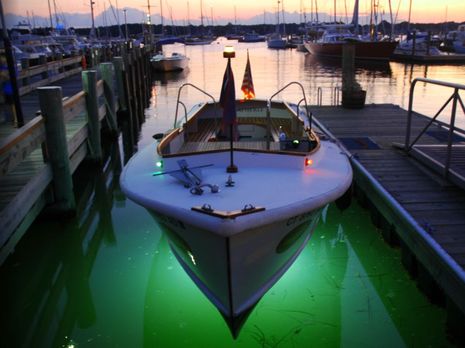 I like the look of underwater lights, but I imagine that the pair on this Dyer 29 launch is also quite useful to the operator and all the passengers stepping on and off in the dark. What’s unusual here is surface-mounted LED light fixtures so thin that installing them around midships made sense. The manufacturer, Macris Industries, also seems to offer a lot of lumens per dollar of fixture cost…
I like the look of underwater lights, but I imagine that the pair on this Dyer 29 launch is also quite useful to the operator and all the passengers stepping on and off in the dark. What’s unusual here is surface-mounted LED light fixtures so thin that installing them around midships made sense. The manufacturer, Macris Industries, also seems to offer a lot of lumens per dollar of fixture cost…
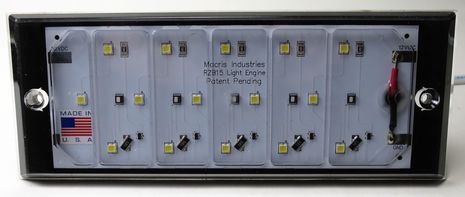 I hadn’t heard of Macris Industries either, until they sent an MIU15 for testing, but it seems they’ve been making interesting underwater LED lights in Mystic, Connecticut, for over a year now. The unusual design is, um, rather transparent: a fully potted polymer sandwich only 0.3-inch thick holds a circuit board with lots of surface-mounted LEDs, but no reflectors or optics whatsoever. The claimed result with the $250 MIU15 fixture above is 1,650+ of widely dispersed bright white LED lumens requiring about 1.75 amps of 12v power.
I hadn’t heard of Macris Industries either, until they sent an MIU15 for testing, but it seems they’ve been making interesting underwater LED lights in Mystic, Connecticut, for over a year now. The unusual design is, um, rather transparent: a fully potted polymer sandwich only 0.3-inch thick holds a circuit board with lots of surface-mounted LEDs, but no reflectors or optics whatsoever. The claimed result with the $250 MIU15 fixture above is 1,650+ of widely dispersed bright white LED lumens requiring about 1.75 amps of 12v power.
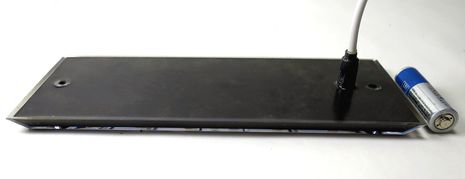 The MIU15 is 7.75 x 3 inches while the $600 MIU30s that Dodson’s Boat Yard installed on their launches are 13.75 inches long; eventually there will be an MIU60 model available that’s over two feet long and 6,000 lumens strong. One concept illustrated on some Macris installs is to wrap the stern of the vessel in a “wall of light.” All three MIU fixtures in various colors will be on display at the Miami Boat Show next week, and also coming are an AL series of utility lights that will have the same ultra-thin panel design, but with frosted lens and reduced lumen output (to handle air cooling instead of water cooling).
The MIU15 is 7.75 x 3 inches while the $600 MIU30s that Dodson’s Boat Yard installed on their launches are 13.75 inches long; eventually there will be an MIU60 model available that’s over two feet long and 6,000 lumens strong. One concept illustrated on some Macris installs is to wrap the stern of the vessel in a “wall of light.” All three MIU fixtures in various colors will be on display at the Miami Boat Show next week, and also coming are an AL series of utility lights that will have the same ultra-thin panel design, but with frosted lens and reduced lumen output (to handle air cooling instead of water cooling).
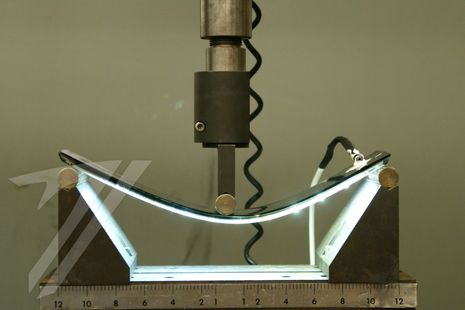 I was pleased to see that Macris claims it’s using top notch 80,000 hour LEDs, offers a two-year warranty, and has put their fixtures through some serious testing. Besides the bending and compression routines shown at that link, you can enjoy a shotgun test. And since I had a couple of vaguely comparable LED lights in stock, I did a quick test myself to get a better sense of what the MIU15 can do.
I was pleased to see that Macris claims it’s using top notch 80,000 hour LEDs, offers a two-year warranty, and has put their fixtures through some serious testing. Besides the bending and compression routines shown at that link, you can enjoy a shotgun test. And since I had a couple of vaguely comparable LED lights in stock, I did a quick test myself to get a better sense of what the MIU15 can do.
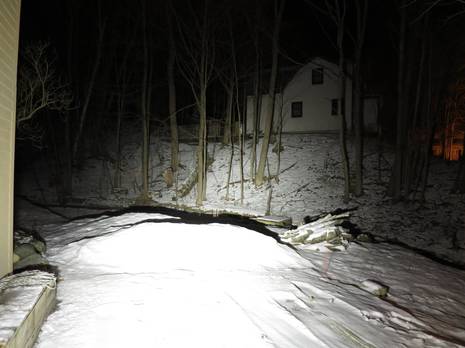 What you’re seeing above is the driveway and (fortunately vacant) neighbor’s house outside my basement lab as illuminated by the same white Ocean LED Amphibian 6 I tested as a masthead light in 2009. It only draws .5 amp and claimed about 400 lumens before it was discontinued, but it still seems fairly powerful, as do the pair of warm white A6s mounted on Gizmo’s transom. (As usual, you can click on these photos to see much higher resolution versions.)
What you’re seeing above is the driveway and (fortunately vacant) neighbor’s house outside my basement lab as illuminated by the same white Ocean LED Amphibian 6 I tested as a masthead light in 2009. It only draws .5 amp and claimed about 400 lumens before it was discontinued, but it still seems fairly powerful, as do the pair of warm white A6s mounted on Gizmo’s transom. (As usual, you can click on these photos to see much higher resolution versions.)
 But, wow, the Macris MUI15 is so much brighter, even though the light is spread wider. I haven’t fiddled with the photos at all and had the tripod-mounted camera on automatic, but it took the Macris image at a 20% faster speed so the light difference is even greater than shown. And mind you, the Macris is less expensive than the A6 was in its day.
But, wow, the Macris MUI15 is so much brighter, even though the light is spread wider. I haven’t fiddled with the photos at all and had the tripod-mounted camera on automatic, but it took the Macris image at a 20% faster speed so the light difference is even greater than shown. And mind you, the Macris is less expensive than the A6 was in its day.
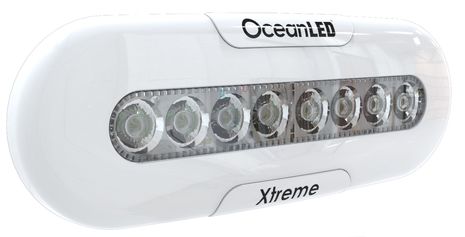 Macris may be a young, hungry company so far mostly selling direct to boaters, but this is also an ongoing story of more LED light and features for your dollar. In fact, OceanLED has a new Amphibian Xtreme series that claims to be “up to 3.5x brighter than any previous Amphibian equivalent.” In the case of the new A8 Xtreme above, that means 1,400 “fixture lumens” for a measly 0.9 amps of 12v (and a street price around $330). And there’s also a new Amphibian Pro Xtreme series, with the same-size A8 Pro model offering 2,100 lumens and an option that enables color switching and strobing with just the two wire power switch or a wireless FOB (also with variable prices). Lumens are a confusing measurement and don’t always line up with reality, but it sure seems like you get a whole lot more OceanLED Amphibian than you used to (a concept I may get to test this spring).
Macris may be a young, hungry company so far mostly selling direct to boaters, but this is also an ongoing story of more LED light and features for your dollar. In fact, OceanLED has a new Amphibian Xtreme series that claims to be “up to 3.5x brighter than any previous Amphibian equivalent.” In the case of the new A8 Xtreme above, that means 1,400 “fixture lumens” for a measly 0.9 amps of 12v (and a street price around $330). And there’s also a new Amphibian Pro Xtreme series, with the same-size A8 Pro model offering 2,100 lumens and an option that enables color switching and strobing with just the two wire power switch or a wireless FOB (also with variable prices). Lumens are a confusing measurement and don’t always line up with reality, but it sure seems like you get a whole lot more OceanLED Amphibian than you used to (a concept I may get to test this spring).
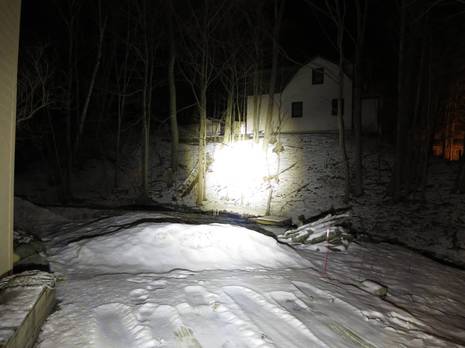 While I was at it, I also powered up a Rigid Industries Marine D Series Dually LED spotlight. When I wrote about Rigid’s entry into the boating market in 2012, they seemed to arrive with excellent optics and compelling lumens-per-dollar designs, not to mention the best torture test video I know of. The photo above shows the original Dually’s 1,300 “raw lumens” highly focused in a way not natural to LEDs (see Macris design) and the currently selling Dually hybrid spot claims 1,568 lumens at the same reasonable 1.1 amps and $120 retail.
While I was at it, I also powered up a Rigid Industries Marine D Series Dually LED spotlight. When I wrote about Rigid’s entry into the boating market in 2012, they seemed to arrive with excellent optics and compelling lumens-per-dollar designs, not to mention the best torture test video I know of. The photo above shows the original Dually’s 1,300 “raw lumens” highly focused in a way not natural to LEDs (see Macris design) and the currently selling Dually hybrid spot claims 1,568 lumens at the same reasonable 1.1 amps and $120 retail.
I had a Rigid D2 with even more lumens projected in a “diffuse hybrid flood” manner from Gizmo’s bow pulpit last season, and it was quite useful for spotting lobster buoys and other hazards at night (and anchor handling). I still haven’t tried the Dually as a semi-portable spot, but I think that a 1-inch RAM ball stud will do the trick, and I expect good results. Meanwhile, Rigid has expanded its marine offerings even to underwater models. But these are only three good marine LED stories, and I haven’t even mentioned interior lighting (where I’ve also found that dedicated LED fixtures far outperform bulb replacements). There are lots of other LED products out there for boats; please share your experiences.


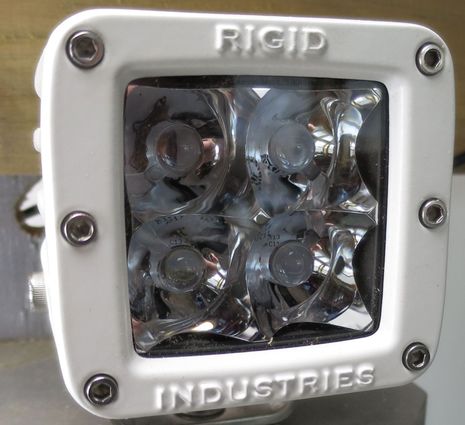
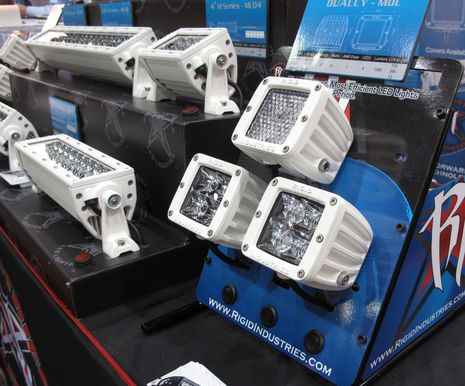
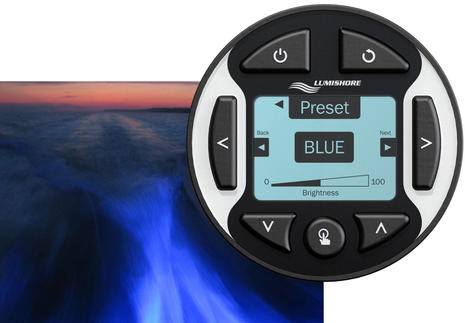
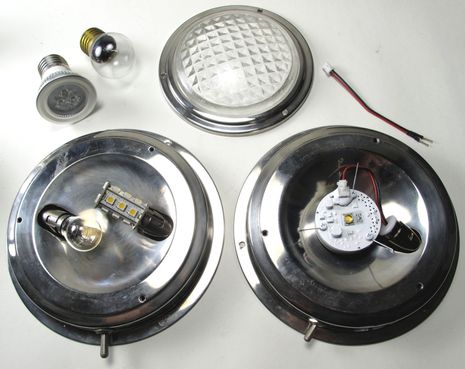








The Rigid website includes a great picture of a Downeast powerboat sporting big LED flood lights in falling snow. I’m nearly positive it’s the Ciloway III owned by Hamilton Marine founder Wayne Hamilton, who probably also took the photo. (Evidence: http://goo.gl/6lZ2Ke and http://goo.gl/P6ZZli )
Wayne likes to think that his boat out gizmoes Gizmo and he may be right 😉
So the Macris lights don’t require holes in the hull? Or do they? It’s not clear to me.
Pretty strange to see the “white” LEDs there.
“White” LEDs are actually blue with yellow luminophore to trick our eyes, it’s well-known fact. Blue->yellow conversion “eats” some amount of light (actually, something like 40-60% depending on color temperature) and gives less than it takes in (70% efficiency is a good number).
Then, this blue-yellow spectrum should pass the ocean water. Let’s look at ocean water visible light adsorption spectrum. For yellow, adsorption is almost ten times stronger than for blue and green.
Therefore, if we’ll count the whole light power of LED chip as 100%, we immediately loose ~15% of power on blue->yellow conversion. Then, light energy of blue light drops ten times after traveling 5 feet. But in the same time, energy of yellow light drops ten times faster.
So, I believe, it’s a great product in mechanical aspect or when used in the air, like the test shots above. But in aspect of efficiency it’s designed in a bit strange way. Keeping in mind degradation of yellow luminophore, I’d personally prefer the combination of monochromatic LEDs like green+blue. Yellow component of spectrum is almost useless for underwater floodlight anyway.
John, I’m not sure it’s possible to have an underwater light without a hole in the hull, with the possible exception of lights mounted on trim tabs. But the surface mounted lights only need a small hole, and they provide plenty of surface around the hole for a good adhesive/waterproof goo seal. The OceanLED A6’s on Gizmo have never leaked a drop and will probably be quite difficult to remove.
Macris claims that the power wire you can see on the back of their lights only requires a 5/16th inch hole but it looks a little bigger to me. However, I didn’t put calibers on it.
Sorry, Bushman, I don’t really get your complaint and am skeptical of your expertise. If you look on the Macris site you’ll see that their lights are available in several colors besides white. I also had an email conversation with Harrison Macris about the nuances of Lumen ratings (complicated!) and was quite impressed with his expertise.
http://www.linkedin.com/pub/harrison-macris/22/9b1/b19
What Bushman was saying is that “white” LEDs are usually blue LEDs with a yellow phosphor, so that the combination of the blue that gets through and the yellow that the phosphor produces makes something that we see as white-ish. As Bushman says, that may not be the best choice for underwater, but the choice of desired effect is best left to the owner.
On the other side of the hull, here is a “why didn’t I think of that” effect:
http://www.westsail42.com/2014/01/subfloor-lighting.html
Thanks, Norse. I guess I was just galled to see an anonymous poster so quick to tear down the work of a young man with such obvious credentials and enthusiasm.
And I still don’t see the point. If there is a better way to make white underwater LED light fixtures, please point us to a manufacturer who uses it. If it’s better to use blue or green LEDs underwater please point us to a site that establishes the reasons why in an understandable way, hopefully with photos.
This entry is about three different marine LED lighting products. Most readers will be here because they’re interested in using those products or ones like them. Please keep the comments relevant.
Ben, two items… First, you stated above; “I had a Rigid D2 with even more lumens projected in a “diffuse hybrid flood” manner from Gizmo’s bow pulpit last season, and it was quite useful for spotting lobster buoys and other hazards at night (and anchor handling).” Seems the light shining on the water at night would reflect back and be blinding. But, I must be missing something. Do you have pictures of how you mounted the light? And, second; Seems the same issue with blinding for lights mounted above the water line noted in this article. I’ve been considering underwater lights at my next haul out, but above the water would ease my nerves about leaks and maintenance if they work well.
Mr. Collier; With several hundred installations in the water since the company’s inception, Macris has yet to receive its first warranty claim. Founder, Harrison Macris, pumped six rounds from a 12-gauge shotgun into an MIU 15 attached to a board and the luminaire remained completely lit AND waterproof. Close inspection of one will show you that materials and construction make it nigh on impossible for it to leak. Even the interior of the power cord has injected sealant! I invite you to visit us and take a look.
DTC
Hi Bo, I’ve never seen a problem with spot light reflecting back from the water, but lots of problems with it illuminating parts of your own boat in the beam. That’s why the bow pulpit install has worked well. I don’t have a great picture of it yet, but you can make it out here:
https://panbo.com/assets_c/2013/03/Gizmo_3-2013_new_antenna_rig_from_bow_cPanbo-7162.html
I was lucky that there was a redundant nav light mounted there that I could easily replace with the Rigid D2.
Here’s a larger scale experiment by Steve Dashew:
http://setsail.com/testing-led-spotlight-configurations-on-the-forward-mast/
with a follow up here:
http://setsail.com/rigid-industries-led-spotlight-update/
I wish Steve would report on the latest configuration worked out but I think that boat is sold and he’s building another. I’m also not clear that he ever tried the Dually model that it is suppossed to throw light the farthest.
I like the Macris approach. If you don’t need a spot beam, why bother with all the optics? My question is can it be used as a spreader light, or does it need to be underwater to get sufficient cooling?
As for LED color temperature and color rendering index, these things are very important for some uses, but as far as I know, the color of underwater lights is strictly user preference. I looked to see if divers used lights other than white and the quick answer was no. The red end of the spectrum gets filtered out by the water, so you could expect dive lights to either boost the red to get better color or to cut the red and save energy, but since they don’t do either, I guess it doesn’t matter that much.
Interesting, Ben. I also note Steve’s comment about being careful not to shine his lights on other vessels. We were once anchored off Santa Barbara Island, with a large power vessel about 500 yards away, and they had their then-new bright underwater stern lights turned on. When the lights were underwater they didn’t bother us, but when their stern raised in the swell, we were subjected to a blinding light that was very annoying (and made stargazing difficult).
Sorta like running a noisy generator in an anchorage, you need to think about how it effects others..:-)
We carry one of those big handheld spotlights for reconning anchorages, and most of the time, it isn’t as effective as a 3D Maglight flashlight with a tightly focused beam because it lights up even a very thin mist or fog that then obscures what’s beyond. We’ve had good luck with having the flashlight holder stand well away from the helm – so the helm can see what they don’t. We also find that the “Scotchbright” type of reflective material is VERY effective in reflecting enough light to see, even through some fog. The white vessel might be close to invisible, but the reflective patches on their foulies and PFDs jump out at you!
I love my Rigid led light lights but like most led the light is directional. placement is very important so test before mounting and on the water most light is reflected off. The biggest complaint on the lights is how bright they are from other boaters.
Yes, the underwater lights can certainly wok out of the water without overheating. However the company also makes an AL series — still completely waterproof and indestructible — but using less power and designed specifically for out-of-water use.